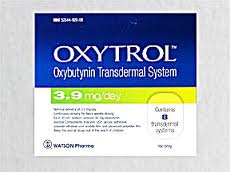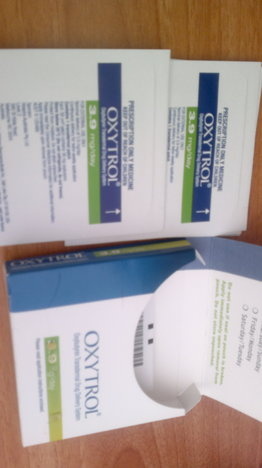英文药名: Oxytrol(Oxybutynin Transdermal System)
中文药名: 奥昔布宁透皮系统贴
生产厂家: Paladin
药品简介
奥昔布宁透皮贴剂(oxybutynin,Oxytrol)是透过皮肤将药物传输入血的一种贴片。由于该产品在治疗中是贴于患者腹部、髋部、臀部进行治疗,不用经过胃肠道系统,可避免其他常用尿失禁药物引起的不良反应如口干、便秘等。该贴剂本身不良反应,例如瘙痒等皮肤刺激。
同之前的口服药物相比,奥昔布宁透皮贴剂既具备抗胆碱药物的治疗优势,又可以避免或减少不良反应的发生,尤其对于一些老年患者来说更是不无裨益。这些患者一直以来服用片剂进行治疗,导致给药负担已经很重,而透皮贴剂的开发不仅提供了新的治疗途径和选择,还能为患者减轻治疗压力。
奥昔布宁透皮系统(Oxybutynin Transdermal System,Oxytrol)由美国Watson公司研制开发, Oxytrol系一透明柔软的薄贴片,1周1~2次贴于腹部、髋部或臀部。本品中的主要成分是奥昔布宁,该药口服制剂25年以来已被人们广泛接受和处方用药。Oxytrol透皮释药系统每日恒速释药3.9mg持续通过皮肤将药物释至全身血液循环,避免口服制剂的肝脏和胃肠道首过代谢,解除膀胱活动过度症状长达4日。
规格:
3.9mg/24hr*8 贴
--------------------------------------------------------------------------------
General Information
 |
The dose of Oxytrol is one 3.9 mg/day system applied twice weekly (every 3 to 4 days).
--------------------------------------------------------------------------------
Clinical Results
FDA approval of Oxytrol was based on the efficacy and safety evaluated in patients with urge/urinary incontinence in two phase III controlled studies and one open-label extension study.
Study 1 was a randomized, double blind, placebo-controlled study, comparing the safety and efficacy of Oxytrol at dose levels of 1.3, 2.6, and 3.9 mg/day to placebo in 520 subjects.
Results showed that subjects experienced a significant reduction in weekly incontinence episodes, urinary frequency, and urinary void volume in active treatment groups versus placebo. An open-label, dose titration treatment extension allowed continued treatment for up to an additional 40 weeks for patients completing the double-blind period. All subjects had urge or mixed incontinence with incontinence episodes of at least 10 per week, and at
least 8 micturitions per day.
Study 2 was a randomized, double blind, double-dummy trial comparing the safety and efficacy of Oxytrol 3.9 mg/day versus active and placebo controls in 361 subjects.
All subjects had urge or mixed incontinence and had achieved a beneficial response from the anticholinergic treatment they were using at the time of study entry. Results showed a significant reduction in daily incontinence episodes, urinary frequency, and urinary
void volume between placebo and active treatment groups.
--------------------------------------------------------------------------------
Side Effects
Adverse events associated with the use of Oxytrol may include (but are not limited to) the following:
Diarrhea
Dysuria
Headache
Dry mouth
Flatulence
Nausea
Abdominal pain
Application site pruritus
Application site erythema
Application site vesicles
--------------------------------------------------------------------------------
Mechanism of Action
Oxybutynin is an antispasmodic, anticholinergic agent. The active
ingredient is dissolved in the thin layer of adhesive that sticks the patch to the skin. Oxytrol delivers the medicine slowly and constantly through the skin and into the bloodstream for the 3 or 4 days that the patch is worn. Oxytrol's transdermal delivery system delivers 3.9 mg per
day of oxybutynin consistently and continuously through the skin into the bloodstream, bypassing initial metabolism in the liver and the gastrointestinal tract that occurs with oral medications, providing relief of overactive bladder symptoms for up to four days.
Patients who have urinary retention, gastric retention, uncontrolled narrow-angle glaucoma or hypersensitivity to oxybutynin or other components of Oxytrol should not use Oxytrol.
--------------------------------------------------------------------------------
Literature References
Birns J, Lukkari E, Malone-Lee JG et al. A randomized controlled trial comparing the efficacy of controlled-release oxybutynin tablets (10 mg once daily) with conventiona oxybutynin tablets (5 mg twice daily) in
patients whose symptoms were stabilized on 5 mg twice daily oxybutynin.
BJU International 2000;85:793-798.
Khoury JM. Urinary incontinence. No need to be wet and upset. NCMJ 2001
Mar/April;62(2):74-77.
Harvey MA, Baker K, Wells GA. Tolterodine versus oxybutynin in the treatment of urge urinary incontinence: a meta-analysis. Am J Obstet Gynecol 2001;185(1):56-61.
Cannon TW, Chancellor MB. Pharmacotherapy of the overactive bladder and advances in drug delivery. Clin Obstet Gynecol 2002 Mar;45(1):205-217.
--------------------------------------------------------------------------------
Additional Information
For additional information regarding Oxytrol or Over-Active Bladder, please contact The Watson Pharmaceuticals Web Page。



